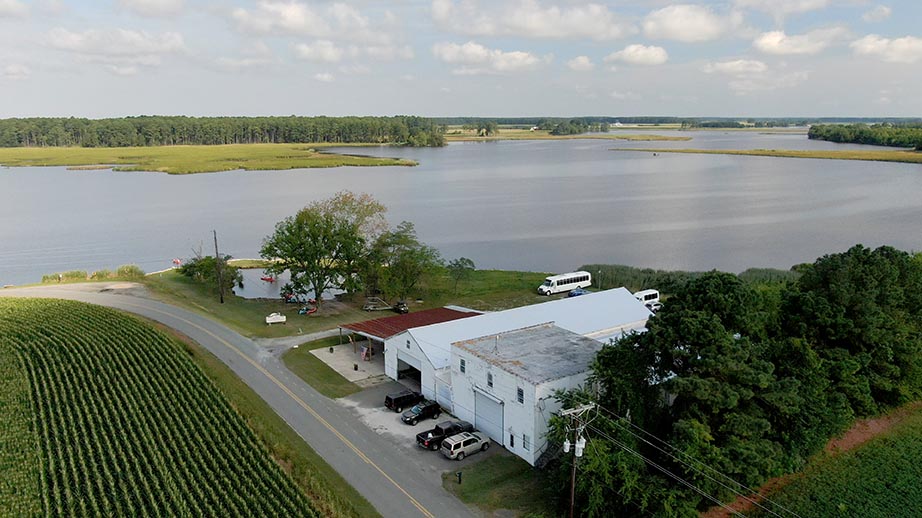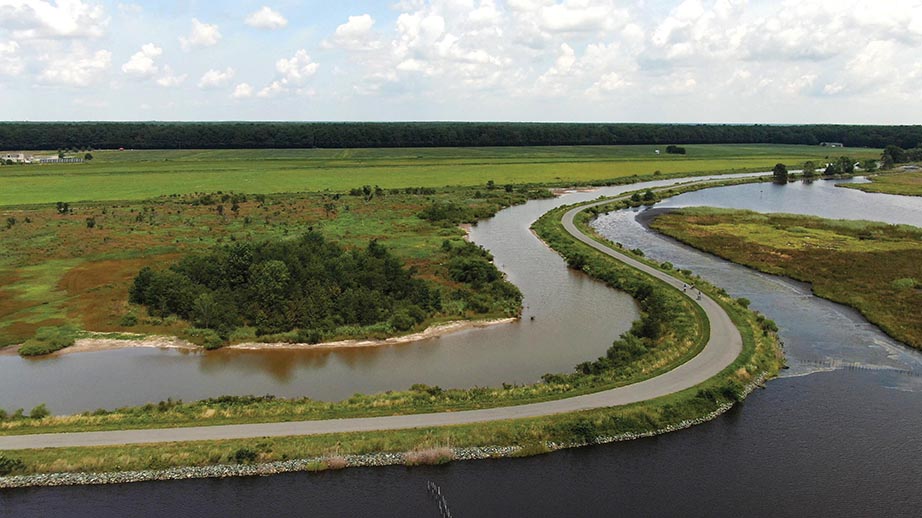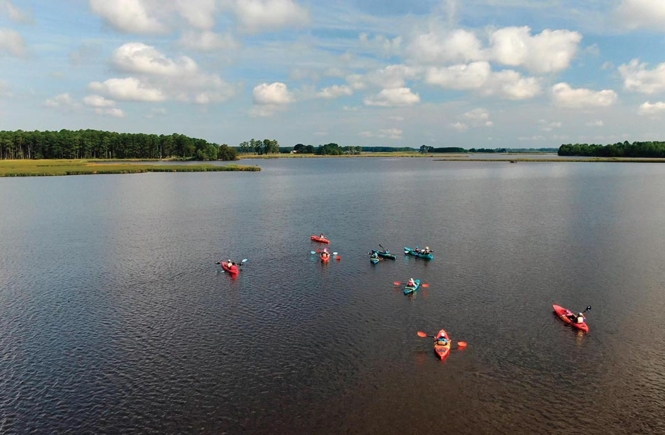TRAVEL WRITER KATIE RILEY VENTURES OFF THE BEATEN PATH TO EXPLORE BLACKWATER NATIONAL WILDLIFE REFUGE FOR THE VERY FIRST TIME
Written by Katie Riley
Photography by Rob Waters
The Blackwater has plenty of stories to tell,” said Matt Meredith, operations manager of Blackwater Adventures, as he shares another anecdote of the region’s history and wildlife while guiding us on a kayaking tour up the Little Blackwater River.
We paddle on, listening to tales of the refuge’s earliest inhabitants and its most famous resident, Harriet Tubman. Each story has this in common: At its heart is the Blackwater National Wildlife Refuge, a landscape of rare and unspoiled splendor.
I had heard about the magic of the Blackwater, of its vast tidal marshes and more than 280 species of resident birds, for years. But I never visited until recently. Tucked away on a peninsula 12 miles south of Cambridge, the Blackwater NWR boasts 30,000 acres of pristine wilderness. Determined to see if the Blackwater NWR lived up to its name as the “Everglades of the North,”
I set out to explore by both land and sea.
I called Blackwater Adventures, the area’s only tour company dedicated to biking, kayaking, fishing and paddleboarding the refuge. The company’s headquarters, just outside the refuge entrance, on the banks of the Little Blackwater River, makes it the perfect spot to launch a kayak.
Matt Meredith is my guide for the morning paddle and afternoon bike ride. After a brief safety lesson and some paddling tips, we climb into our kayaks and adjust the pedals and backrests for a comfortable ride. Matt carefully explains how to use the blade of the paddle efficiently, so I won’t tire easily, and we are off, gliding out of the cove and into the river.
The name Blackwater is derived from the tea-colored waters, which are darkened from the tannin that is picked up as the water drains through the peat soil in the marshes. Indeed, its cloudy appearance makes it difficult to discern the depth or the water’s inhabitants. Matt assures us that the river is only a few feet deep, making it an ideal setting for novice kayakers. Shallow and brackish, he explains that the river attracts fishermen in search of the elusive snakehead fish, a culinary delicacy.
The lack of current makes for an easy paddle, and soon we are far from shore, passing several osprey nests, in search of our first eagle sighting. The Blackwater NWR boasts the largest concentration of nesting bald eagles north of Florida, and we are quickly rewarded for our efforts as we spy a giant eagle’s nest through a stand of loblolly pines. A closer look as we paddle around the side of the marsh reveals its owner, a majestic bald eagle perched on a nearby branch.
We paddle on, watching an osprey swoop low across the river, and at the next turn, we are greeted by a great blue heron, wading for fish near the shoreline. A paddle through the Blackwater is a fully immersive experience, unspoiled by the hum of motorboats or road noise. The only sound as we make our way up the river is the distant drumming of a woodpecker and the gentle lapping of waves as we slice through the water.

Paddling past a huge stretch of marsh grass, we look for muskrats and other critters. Matt explains the federal government’s efforts to protect the grass from invasive species, like nutria, a rodent that was introduced to the refuge in the 1940s by trappers who sold their fur. The rodent’s voracious appetite for marshlands has destroyed thousands of acres of wetland over the years, but through the Chesapeake Bay Nutria Eradication project, they have nearly vanished from the area.
At every turn, it becomes clear that Matt Meredith is not your average outdoor enthusiast. Certified as a Master Naturalist, his breadth of knowledge about the land and its inhabitants is staggering. As a teen, he began working at a nearby conservation, and he shares his family’s passion for preserving and promoting the area’s natural resources.
“When you dive deep into this stuff, it leaves you wanting to know more,” he said. “I believe that as a student of nature and wildlife, it takes a lifetime to know it all.”
Noting that his mother, Susan Meredith, was also out on the river that day, on a guided paddle with an expert birder, Matt directs us farther upriver, to another eagle’s nest, this one even larger than the first.
Our late-summer paddle is filled with sightings of heron, eagles and osprey, but the refuge truly comes alive in the fall, when upwards of 35,000 geese and 15,000 ducks descend on the area. The refuge’s mix of salt and fresh water attracts a huge variety of river and puddle ducks, such as widgeons, mallards and black ducks.
“In the fall, the refuge becomes a huge melting pot of every kind of waterfowl imaginable, and the roar of the ducks and geese can wake you up at night,” Matt said.

We arrive back at the creek bank, eager to gain a new perspective of the refuge on land. Suiting up with helmets and bikes, we head out toward Wildlife Drive, at the entrance of the refuge, just a quarter-mile down the road.
An enormous butterfly garden, home to a variety of flora and fauna, greets visitors at the park’s entrance. Biking up Wildlife Drive, we spot another great blue heron, sunning itself in the freshwater wetland. Matt explains how the wildlife service drains the wetlands during the summer months to encourage plant growth, such as wild millet and smartweed, which will later provide food for waterfowl during the fall season.
We continue down a stretch of Wildlife Drive before turning toward the Marsh Edge Trail. After a short ride through loblolly pines inhabited by a flock of turkey vultures, the trail opens up to a vast view of wetlands and marsh as far as the eye can see. The landscape is dotted with dead ghost trees, beautiful in their sparseness, but a harsh reminder of how rising sea levels and saltwater intrusion can wreak havoc on plant life. Since the 1930s, more than 5,000 acres of tidal marsh have been lost in the Blackwater River system.
At the end of the Marsh Edge Trail lies an observation platform with panoramic views of the Blackwater River. Matt explains the history of the Nause Waiwash Indians, descendants of the Nanticoke tribes that built cabins along the river. He also points out locations where the remains
of trapper cabins from the 1930s can still be found.
We head back, turning down the Woods Trail, a forested area that is home to the Delmarva Peninsula Fox Squirrel, a formerly endangered species native to the shore. Another common sight is the sika deer, an Asian species of elk introduced to the area in the early 20th century. Cloaked in the canopy of the trees, the trail feels a world apart, and aside from the lone birder who is scanning the trees for woodpeckers and swallows, we are the only visitors on the entire stretch
of road.

Emerging from the forest, we are again greeted with another vast panorama of surrounding marshes and quickly spot a snapping turtle swimming in the tidal waters. Blackwater is home to more than 45 species of reptiles and amphibians, and diamondback and redbelly turtles are a common sight.
The trail leads to another observation deck and loops around to the Blackwater Visitors Center, where it connects to a larger network of roads just outside the refuge gates. We reluctantly turn back toward the entrance, soaking in the sights and sounds of the Blackwater: the call of the red-winged blackbird and the majesty of a bald eagle soaring effortlessly across the treeline.
After a day paddling its waters and biking its trails, the Blackwater has cast its spell, ensuring my inevitable return. Rachel Carson, the writer, conservationist and Maryland resident, once wrote:
“In every outthrust headland, in every curving beach, in every grain of sand, there is the story of the earth.” The Blackwater indeed has an enduring tale to tell, of a quiet wilderness that whispers its stories, again and again, to all who will listen.





